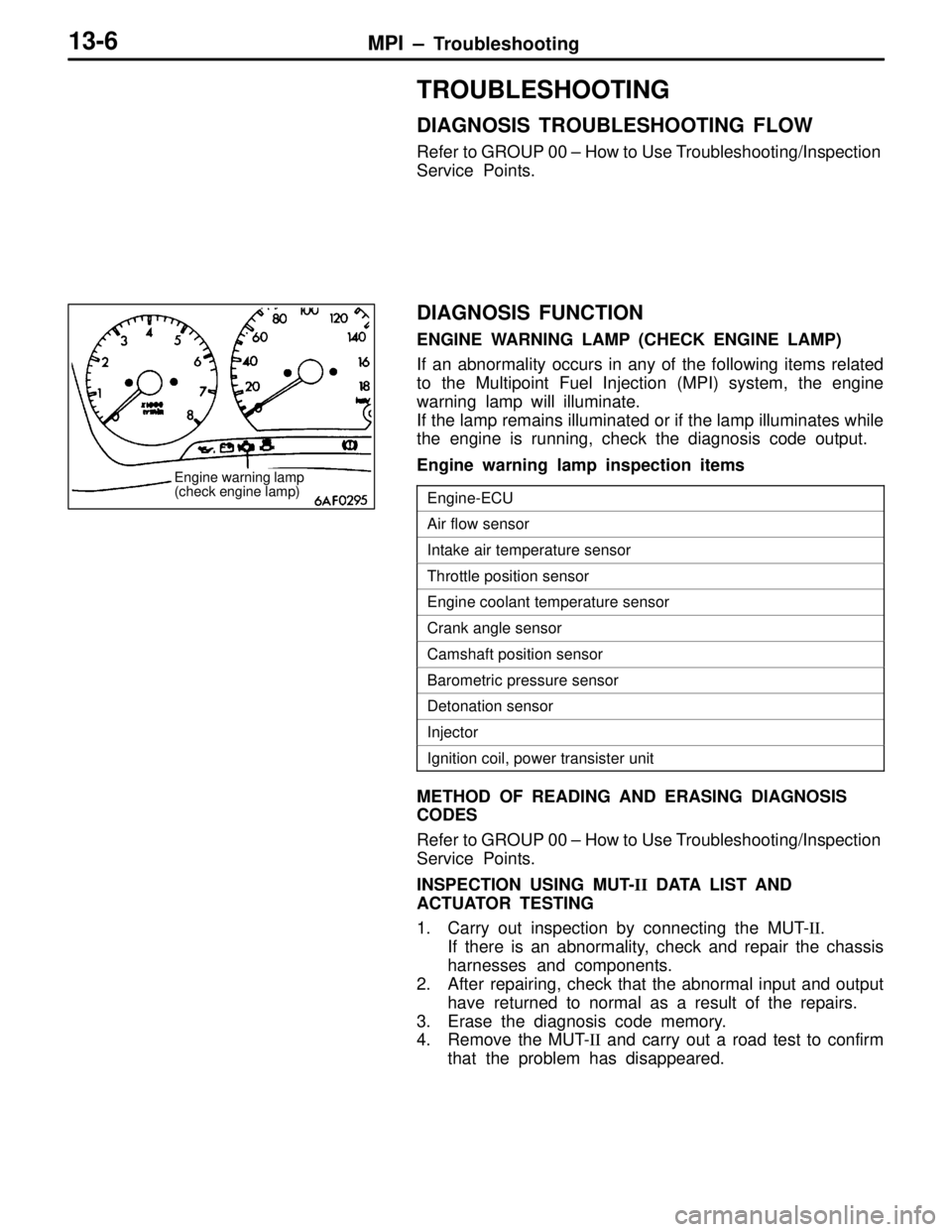Page 106 of 558
ENGINE – Alternator11-81
�B�ROTOR INSTALLATION
After installing the rotor, remove the wire used to fix the brush.
INSPECTION
ROTOR CHECK
(1) Check the continuity between the rotor coil slip rings,
and replace the rotor if the resistance value is not at
the standard value.
Standard value: 3 – 5 Ω
(2) Check the continuity between the slip ring and core, and
if there is continuity, replace the rotor.
STATOR CHECK
(1) Check the continuity between the coil leads, and if there
is continuity, replace the stator.
(2) Check the continuity between the coil and core, and if
there is continuity, replace the stator.
Wire
Page 107 of 558

ENGINE – Alternator11-82
RECTIFIERS CHECK
(1) Inspect the (+) heat sink by checking the continuity
between the (+) heat sink and stator coil lead wire
connection terminal using a tester probe.
If there is a continuity at both, the diode is short circuited,
so replace the rectifier.
(2) Inspect the (–) heat sink by checking the continuity
between the (–) heat sink and stator coil lead wire
connection terminal using a tester probe.
If there is a continuity at both, the diode is short circuited,
so replace the rectifier.
(3) Check the diode trio by connecting an ohmmeter to both
ends of each diode and check the continuity of the three
diodes.
If there is a continuity at both ends, or if there is no
continuity, the diode is damaged so replace the recitifier.
BRUSH CHECK
(1) Measure the length of the brush protrusion shown in the
illustration, and replace the brush if the measured value
is below the limit value.
Limit: 2 mm or less
(2) The brush can be removed if the solder of the brush
lead wire is removed.
(3) When installing a new brush, insert the brush into the
holder as shown in the illustration, and then solder the
lead wires.
Protrusion
length
Soldered
Page 109 of 558

ENGINE – Starter Motor11-84
DISASSEMBLY SERVICE POINTS
�A�MAGNETIC SWITCH REMOVAL
Disconnect field coil wire from “M” terminal of magnetic switch.
�B�ARMATURE / BALL REMOVAL
Caution
When removing the armature, take care not to lose the
ball (which is used as a bearing) in the armature end.
�C�SNAP RING / STOP RING REMOVAL
(1) Press stop ring off snap ring with a suitable socket.
(2) Remove snap ring with snap ring pliers and then remove
stop ring and overrunning clutch.
STARTER MOTOR PARTS CLEANING
(1) Do not immerse parts in cleaning solvent. Immersing the
yoke and field coil assembly and/or armature will damage
insulation. Wipe motor assembly with a cloth only.
(2) Do not immerse drive unit in cleaning solvent. Overrunning
clutch is pre-lubricated at the factory and solvent will wash
lubrication from clutch.
(3) The drive unit may be cleaned with a brush moistened
with cleaning solvent and wiped dry with a cloth.
Magnetic
switch“S” terminal
“B” terminal
Field coil wire “M” terminal
Stop ringSocket
Pinion gear
Overrunning
clutch
Armature
Snap ring
Pinion gear
Overrunning
clutchSnap ring pliers
Armature
Page 111 of 558

ENGINE – Starter Motor11-86
OVERRUNING CLUTCH CHECK
(1) While holding clutch housing, rotate the pinion. Drive
pinion should rotate smoothly in one direction, but should
not rotate in opposite direction. If clutch does not function
properly, replace overrunnig clutch assembly.
(2) Inspect pinion for wear or burrs. If pinion is worn or burred,
replace overrunning clutch assembly. If pinion is damaged,
also inspect ring gear for wear or burrs.
FRONT AND REAR BRACKET BUSHING CHECK
Inspect bushing for wear or burrs. If bushing is worn or burred,
replace front bracket assembly or rear bracket assembly.
BRUSH AND SPRING REPLACEMENT
(1) Brushes that are worn beyond wear limit line, or oil-soaked,
should be replaced.
(2) When replacing ground brush, slide the brush from brush
holder by prying retaining spring back.
ARMATURE TEST
ARMATURE COIL SHORT-CIRCUIT TEST
(1) Place armature in a growler.
(2) Hold a thin steel blade parallel and just above while rotating
armature slowly in growler. A shorted armature will cause
blade to vibrate and be attracted to the core. Replace
shorted armature.
ARMATURE COIL EARTH TEST
Check the insulation between each commutator segment and
armature coil core.
If there is no continuity, the insulation is in order.
Free
Lock
Wear limit line
Growler
Page 112 of 558
ENGINE – Starter Motor11-87
ARMATURE COIL OPEN-CIRCUIT INSPECTION
Check the continuity between segments. If there is continuity,
the coil is in order.
Page 115 of 558

MPI – General13-3
MPI System Diagram
�1 Injector
�2 ISC servo
�3 Fuel pressure control valve
�4 Waste gate solenoid valve
�5 Secondary air control solenoid valve
�Control relay
�Fuel pump relay
�A/C relay
�Ignition coil
�Exhaust temperature warning lamp
�Engine warning lamp
�Diagnosis output
�Alternator G terminal
�Fan motor relay
�Tachometer
�Fuel pump relay No.2 �1 Oxygen sensor
�2 Air flow sensor
�3 Intake air temperature sensor
�4 Throttle position sensor
�5 Idle switch
�6 Camshaft position sensor
�7 Crank angle sensor
�8 Barometric pressure sensor
�9 High temperature sensor
�10 Engine coolant temperature sensor
�11 Detonation sensor
�Power supply voltage
�Ignition switch-IG
�Ignition switch-ST
�Vehicle speed sensor
�A/C switch
�Power steering fluid pressure switch
�Alternator FR signalEngine ECU
�1 Oxygen sensor
�2 Air flow sensor�3
Intake air tem-
perature sensor
�4,
�5
�6 Camshaft position
sensor
�7 Crank angle sensor �8 Barometric
pressure sensor
�9 High temperature
sensor �10 Coolant temperature sensor
�11 Detonation sensor�1 Injector �2 ISC servo
�3 Fuel pressure
control valve
�4 Waste gate
solenoid valve �5 Secondary air
control solenoid
valveCanister
Check valveFrom
fuel
tank
Throttle position
sensor (with a
built-in
idle
switch)
Secondary
air valve
AirTo fuel
tankFuel
pressure
regulatorFrom
fuel
pump
Waste gate
actuator
Catalytic converter
Page 116 of 558
MPI – Service Specifications / Sealant13-4
SERVICE SPECIFICATIONS
ItemsSpecifications
Basic ignition timing �BTDC5 ± 3
Basic idle speed rpm850 ± 50
Throttle position sensor adjusting voltage mV400 – 1,000
Throttle position sensor resistance kΩ3.5 – 6.5
ISC servo coil resistance (at 20�C) Ω28 – 33
Intake air temperature sensor resistance kΩAt 20�C2.3 – 3.0
At 80�C0.30 – 0.42
Coolant temperature sensor resistance kΩAt 20�C2.1 – 2.7
At 80�C0.26 – 0.36
Fuel pressure kPaWhen vacuum hose is connected230
When vacuum hose is disconnected289 – 309
Injector coil resistance Ω2 – 3
Amount of injector fuel leak drop/min1 or less
Oxygen sensor output voltage V0.6 – 1.0
Fuel pressure control valve coil resistance (at 20�C) Ω28 – 36
SEALANT
ItemSpecified sealantRemark
Engine coolant temperature sensor
threaded portion3M Nut Locking Part No.4171 or equivalentDrying sealant
Page 118 of 558

MPI – Troubleshooting13-6
TROUBLESHOOTING
DIAGNOSIS TROUBLESHOOTING FLOW
Refer to GROUP 00 – How to Use Troubleshooting/Inspection
Service Points.
DIAGNOSIS FUNCTION
ENGINE WARNING LAMP (CHECK ENGINE LAMP)
If an abnormality occurs in any of the following items related
to the Multipoint Fuel Injection (MPI) system, the engine
warning lamp will illuminate.
If the lamp remains illuminated or if the lamp illuminates while
the engine is running, check the diagnosis code output.
Engine warning lamp inspection items
Engine-ECU
Air flow sensor
Intake air temperature sensor
Throttle position sensor
Engine coolant temperature sensor
Crank angle sensor
Camshaft position sensor
Barometric pressure sensor
Detonation sensor
Injector
Ignition coil, power transister unit
METHOD OF READING AND ERASING DIAGNOSIS
CODES
Refer to GROUP 00 – How to Use Troubleshooting/Inspection
Service Points.
INSPECTION USING MUT-II DATA LIST AND
ACTUATOR TESTING
1. Carry out inspection by connecting the MUT-II.
If there is an abnormality, check and repair the chassis
harnesses and components.
2. After repairing, check that the abnormal input and output
have returned to normal as a result of the repairs.
3. Erase the diagnosis code memory.
4. Remove the MUT-II and carry out a road test to confirm
that the problem has disappeared.
Engine warning lamp
(check engine lamp)